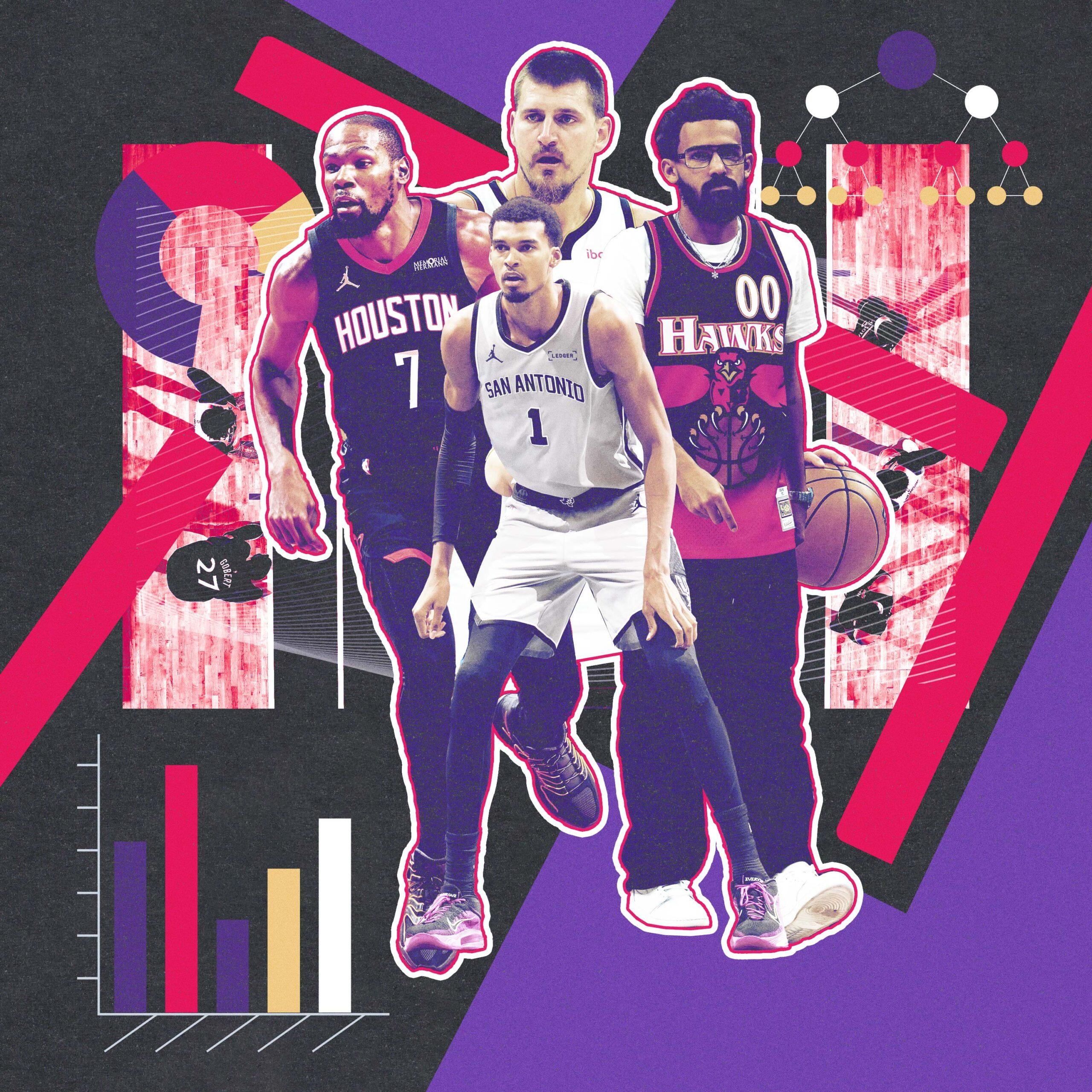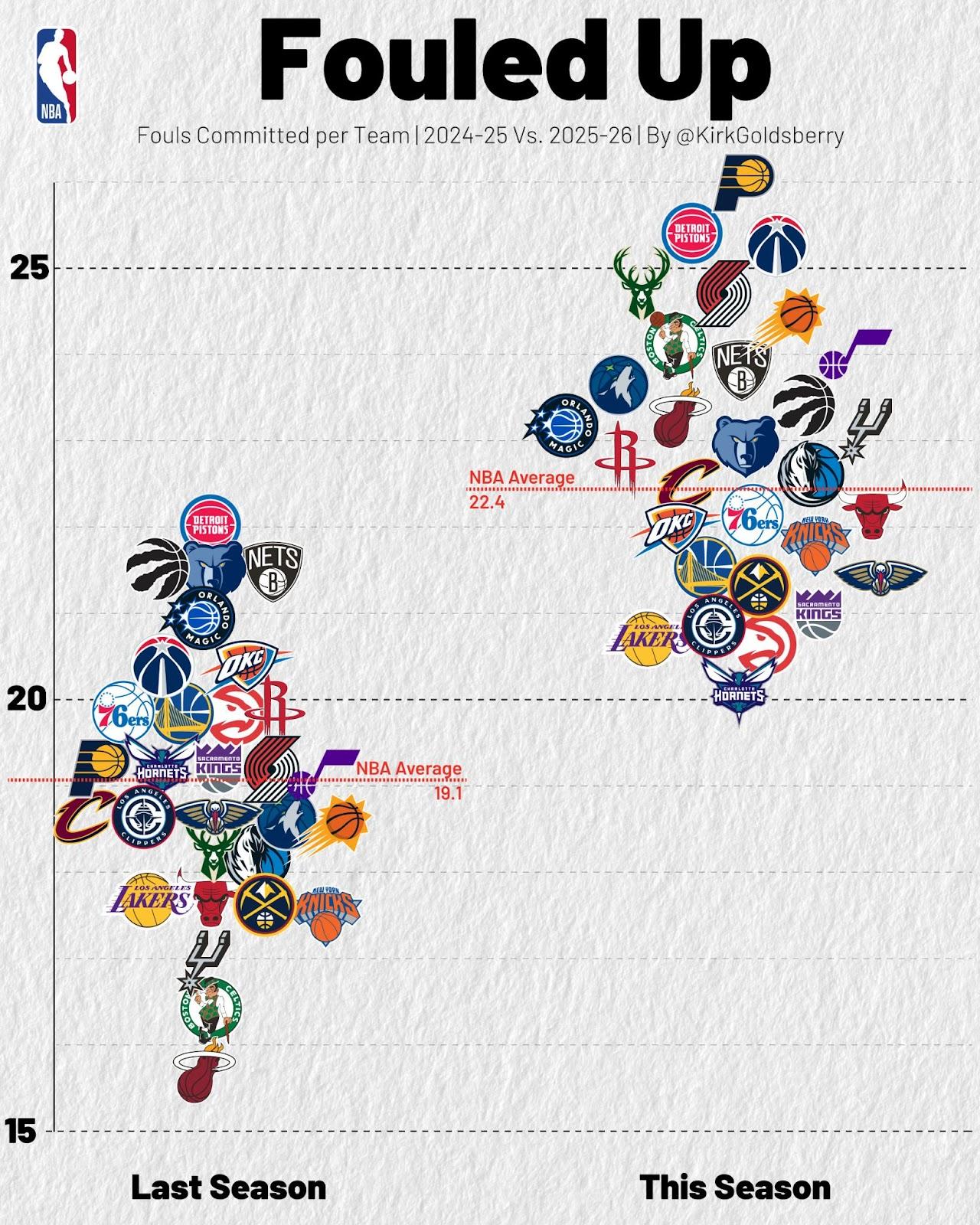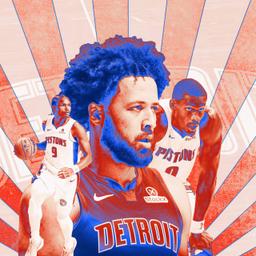
The 2025-26 season is nearly one month old, and we're learning more about the NBA landscape with each passing game. In this column, we'll provide insight into and analysis of a handful of ongoing trends that NBA fans should know about. Today, we're looking at whether the Spurs can survive Victor Wembanyama’s injury, the Rockets' unusual but highly effective offense, a free throw bonanza, and more.
These Spurs can survive without Wemby.
On Monday afternoon, news broke that San Antonio Spurs star Victor Wembanyama has a left calf strain and is expected to be sidelined for a few weeks. The injury is a big deal for a young 9-4 squad that is beginning to develop a winning identity, especially because much of that identity is built around its phenomenal young center.
The Spurs are outscoring opponents by nearly nine points per 100 possessions when Wemby is on the court, but that figure dips all the way down to two per 100 when he’s not. That’s actually good news compared with last season, when the team got boat raced anytime Wemby was off the floor.
San Antonio is in better shape to survive games without Wemby this season for two main reasons. First, Luke Kornet is a serviceable big man—the Spurs didn’t have such a reliable backup center last year. In Wemby’s absence, Kornet started San Antonio’s game against the Kings on Sunday and helped the Spurs hold the line in the middle to win by 13. The second reason is De’Aaron Fox. Last year, the Spurs lacked the exact kind of offensive leadership that Fox brings to the table. In that same win over the Kings, Fox led all scorers with 28 points and also dished out 11 assists. Those are All-Star numbers. Add in the fact that the rest of the team’s young core has leveled up, and it’s fair to expect this year’s squad to play adequate hoops without its giant French leader.
The Atlanta Hawks are quietly cooking without Trae.
The biggest question mark in the NBA right now is wearing street clothes, as Trae Young has missed the past nine games for the Atlanta Hawks because of a knee sprain. The injury comes at a tricky and fascinating time: Young and the Hawks did not reach an agreement on a long-term contract extension over the summer, and the four-time All-Star has a player option after this season that suddenly seems like the most fascinating subplot in the league. Why? Because there’s a growing chorus around the NBA that believes Atlanta might be better off without him.
The Hawks are 2-3 in the five games they have played with Young in the lineup; they are 7-2 in the nine games he’s missed. More specifically, the Trae-less Hawks have won five straight games, including going undefeated on a four-game road trip out West. If you're wondering when Atlanta last swept a trip like that, the answer is never.
More to the point, key indicators like this are getting harder to ignore: In 139 minutes with Young on the floor this season, the Hawks have a net rating of –9.2. In 533 minutes without him, their net rating is +6.4.
Let’s get nerdier. Here’s what this disparity looks like in the leaguewide efficiency landscape. As you can see, when Young is off the floor, the Hawks profile as a contender, exhibiting marks similar to those of the East-leading Pistons. But with Young on the floor, the team’s indicators look like Brooklyn’s.

It’s probably too early to conclude that they’re better without their four-time All-Star, especially when you consider that just last season (not ancient history), the Hawks could not score the ball without Young in the fold. But early on this year, the Trae-less Hawks are humming a different tune. Atlanta’s offensive rating without Young is up at 114.4 points per 100 possessions—and anyone who watched the Hawks beat the red-hot Suns in Phoenix on Sunday caught a glimpse of something scary: Atlanta ripped off 47 points in the final 12 minutes to come from behind and steal the road win. Offseason addition Nickeil Alexander-Walker, Dyson Daniels, Jalen Johnson, and Onyeka Okongwu played virtually the whole quarter and helped the team end the road trip with an exclamation point.
The lineups without Young are stacked with longer arms and taller frames, and so far this year, these groups have fared quite well, especially on defense. With Young on the floor, the team is allowing 123.2 points per 100, which would rank 28th in the NBA. When he’s out, that number drops to 108, which would rank second. The non-Trae lineups have an elite defensive ceiling to go with a more egalitarian offensive culture led by Johnson, who might just be an All-Star this season. It’s beginning to look like a new era is launching in Atlanta.
The key to Houston’s top-ranked offense isn’t Rocket science. It’s brute force.
OK, here’s a riddle: In the modern NBA, how can a team have the league’s most efficient offense despite the fact that it takes the fewest 3-point shots?
The answer is twofold: Kevin Durant and incredible rebounding.
The 9-3 Houston Rockets rank last in the NBA in 3-point attempts per contest, with just 30.3, but rank first in the league in points per 100 possessions, scoring a whopping 123.4. Of course, it all starts with Durant, who is offensive efficiency in a can. At 37, the Slim Reaper remains the game’s purest scorer. He’s once again flirting with 50/40/90 shooting splits while racking up more than 26 points per game, stunning stats for any player, let alone a near-7-footer playing in his 18th NBA season.
Durant is unguardable; we’ve known this for a long time. But here’s the added wrinkle in H-Town: Even when he misses, the defense’s nightmare is by no means over. Collecting basic defensive rebounds when dudes like Alperen Sengun, Steven Adams, Amen Thompson, and Clint Capela are crashing the glass is a horror movie for opposing frontcourts. Just ask the Bucks, who lost to Houston earlier this month in large part because the Rockets had as many offensive boards as the Bucks had defensive boards; Houston won the overall rebounding battle 50-27.
Houston’s offensive rebounding stats are far and away the best in the association. They rank first in the NBA by recovering over 49 percent of their own missed layups and first in the NBA by recovering over 36 percent of their own missed jumpers. In addition, they have more second-chance points than any other team, and their overall offensive rebounding rate is the highest mark in more than 30 years.
Opposing defenses not only have to force Durant and Co. to misfire but also have to finish the possession against the armada of gargantuan athletes Ime Udoka has crashing the glass.
The definition of a foul has shifted. Again.
Back on November 5, a star-studded crowd filled up Crypto.com Arena to watch a high-profile matchup between Victor Wembanyama and Luka Doncic, but the real stars of the game were the officials. With Leo DiCaprio sitting courtside, that night’s crew called a staggering 66 fouls that resulted in 84 free throws. All those trips to the stripe slowed down the game, which lasted a ridiculous 2 hours and 54 minutes—14 minutes longer than Once Upon a Time … in Hollywood.
After the victory, Lakers head coach JJ Redick lamented the plethora of fouls. “There were just a lot of touch fouls tonight. It kind of disrupted the flow for both teams.” The Los Angeles Times called the game “unsightly.”
Nobody likes to watch free throws, but that Spurs-Lakers game was the most high-profile example of a big early-season trend: The average game this season includes eight more free throws than the average game last season. Let’s dive deeper:
- Last year, seven NBA teams committed more than 20 fouls per game. This year, all 30 are.
- Last year, the Lakers led the entire NBA in free throw rate, at 27.1 percent. That same figure would rank 25th this year.

What’s going on? Some of this says more about last year than this one. In 2024-25, the league’s overall free throw rate of 18.9 percent was the lowest of all time, and this year’s figure of 22.8 percent is partly a return to normalcy.
Still, between last year’s historically low free throw rate in the regular season, the brutality allowed in last year’s full-contact postseason, and the sudden surge in whistleblowing so far this season, coaches and players are more confused than ever about contact allowances in the NBA.
The Detroit Pistons’ revival is powered by a paint job.
Turn on some Seger, folks: The hottest basketball team on planet earth hails from the Motor City. Detroit is 12-2, first place in the Eastern Conference, and it owns the current longest winning streak in the league. While Cade Cunningham is the face of the team, let’s give some shine to some of his lesser-known teammates, specifically Jalen Duren and Isaiah Stewart, who are teaming up to form one of the most physically imposing frontcourts in pro hoops.
The Pistons have been strong on both ends of the floor early on, but their signature dominance has taken place inside. This should surprise no one who has watched Duren and Stewart play basketball. These two bad boys evoke a certain kind of physicality that fits perfectly in the land of Rick Mahorn, Bill Laimbeer, Dennis Rodman, and Ben Wallace. But it’s more than just heritage; Detroit ranks first in the league in points per game in the paint, scoring 58.3, and ranks fourth in points scored by opponents in the paint, allowing only 43.2 per game.
In other words, they are winning by controlling the interior, and it’s setting the tone for an exciting new era of Pistons basketball. If they can keep this up, the glory days might be coming back to the 313.
Nikola Jokic has gone up a(nother) level.
Did you think we had already reached peak Joker? Think again. Just when you think Jokic’s numbers could not get any zanier, they do—even by his ridiculous standards. Let’s start with two basic facts: One, Jokic leads the NBA in rebounding. Two, he leads the NBA in assists.
No player in NBA history has ever led the league in those two fundamental categories over the course of a season. Not even Wilt. Jokic may not end up at the top of these leaderboards when it’s all said and done, but he’s there through 12 games, which is remarkable on its own. And this is just the beginning—the dude is also by far the most efficient volume scorer in the league.
So far this season, 147 players have taken at least 100 shots; that’s about a third of the entire league. Of this immense group, Jokic is yielding the highest return, averaging an absurd 1.49 points per attempt.

We saw the Joker’s magic up close on a road back-to-back last week: He made 34 of his 42 shots as the Nuggets beat the Kings and Clippers on consecutive nights. Thirty-four of 42! It’s not like Jokic had an efficiency problem to overcome, yet he’s currently on pace to set career marks in 3-point percentage, free throw percentage, and 2-point percentage. In fact, those numbers inside the arc might be the most mind-blowing—Jokic is making a staggering 77 percent of his 11.5 2-point tries per game.
TL;DR: He’s the MVP so far. Sorry, Shai.
Stats are updated through Sunday’s games.







